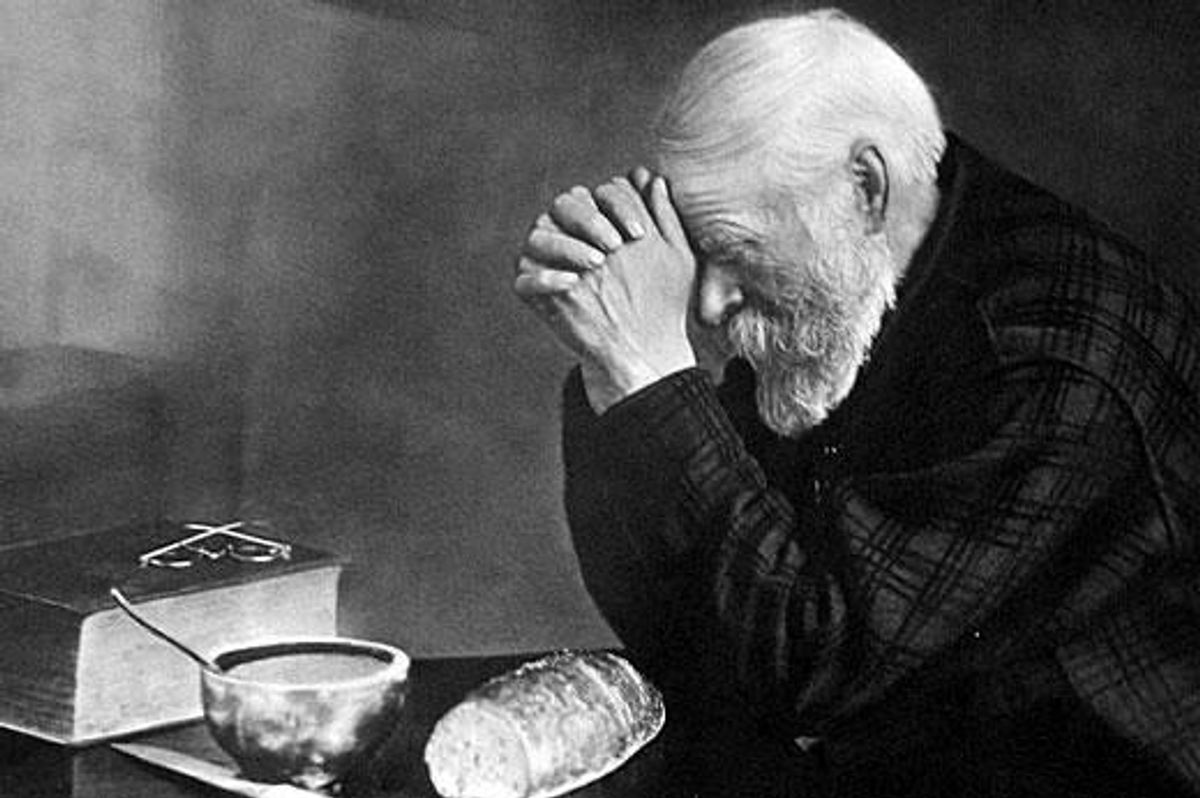Guy reveals why the 'old man praying’ painting you see everywhere is not what it seems
It started as a photograph.

The Minnesota state photograph "Grace" by Eric Enstrom depicts traveling salesman Charles Wilden in Bovey, Minnesota.
The painting of an old devout man praying over a bowl of gruel and a loaf of bread in front of a Bible is one of the most popular pieces of 20th century American art. The piece is called “Grace” and you’ll find it in homes, churches and even restaurants.
I clearly remember there was a copy of it hanging on the wall at my corner burger joint, Mack’s Burgers, in Torrance, California, in the ’80s. Sadly, it’s been torn down and is now a Jack in the Box. However ubiquitous the photo may be, a new video by pop culture YouTube user Austin McConnell shows that “Grace” isn’t really what it seems.
“Grace” was originally a photograph taken in 1918, during World War I, by Eric Enstrom, a Swedish American from Bovey, Minnesota. Enstrom was preparing some photographs to take with him to a convention when Charles Wilden, a salesman selling boot scrapers, came to his door, and he know he had to take his photo.
“There was something about the old gentleman’s face that immediately impressed me. I saw that he had a kind face… there weren’t any harsh lines in it,” Enstrom said. “I wanted to take a picture that would show people that even though they had to do without many things because of the war they still had much to be thankful for,” he added.
“There was something about the old gentleman’s face that immediately impressed me. I saw that he had a kind face… there weren’t any harsh lines in it,” Enstrom said. “I wanted to take a picture that would show people that even though they had to do without many things because of the war they still had much to be thankful for,” he added.
Enstrom posed Wilden in front of a loaf of bread, a bowl—which may have been empty—and a large book that many assume to be the Bible. But, as McConnell notes, the book is far too large to be the good book, as most people assume. The Grand Forks Herald claims that a receipt for payment from Enstrom to Wilden reveals that the book is a dictionary.
The photograph went on to be a huge hit at the convention and Enstrom began selling copies about town. After many requested copies of the photo in color, Enstrom’s daughter, Rhoda Nyberg, began hand-painting them in oils and added a streak of light on the left side of the painting. This is the version that people have come to love.
\u201c@BrentTerhune The artist who hand- colored \u201cGrace,\u201d a photo showing a white-bearded man bowed in prayer before a simple meal, was Rhoda Nyberg, the daughter of Eric Enstrom. Rhoda's father took the photo in his studio in Bovey, Minnesota in 1918.\n\nRhoda Nyberg died at the age of 95. in 2015.\u201d— Brent Terhune in Akron Jan 6 & 7 (@Brent Terhune in Akron Jan 6 & 7) 1640282253
"The intent of the photo is fairly obvious,” McConnell says in the video. “Enstrom wanted an image that conveyed to people that even though they had to do without many provisions because of the ongoing war, there was still much to be thankful for. A picture that seemed to say 'this man doesn't have much of earthly goods, but he has more than most people because he has a thankful heart.'"
Enstrom convinced Wilden to sign over his rights for $5, which gave him the sole copyright. He then licensed the image to the Lutheran-affiliated Augsburg publishing house, which distributed the image across the country.
According to McConnell “thousands and thousands” of copies of the photo were sold. The image entered the public domain in 1995.
Although not much is known about Wilden, it is believed that he lived a hard life. "He was living in a very primitive sod hut near Grand Rapids, eking out a very precarious living," retired history professor Don Boese told the Grand Forks Herald. It’s also likely that he wasn’t the devout man we imagine in the photo. "The stories about him centered more around drinking and not accomplishing very much,” Boese said.
So the painting was actually a photo. The Bible, a dictionary, and the subject was more likely to be the town drunk than a saint. But, in the end, does it matter? McConnell believes that its meaning rests in the eye of the beholder.
"If you found out today that everything you thought you knew about this iconic image was actually wrong, would you take it off your wall?” McConnell asks at the end of the video. “Or would you accept that the value in a piece of art isn't merely derived from the knowledge of how it was made? Or who made it?”
This article originally appeared three years ago.

